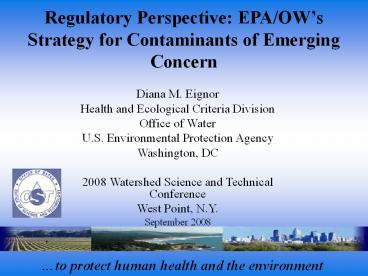Regulatory Perspective: EPA/OW - PowerPoint PPT Presentation
Title: Regulatory Perspective: EPA/OW
1
Regulatory Perspective EPA/OWs Strategy for
Contaminants of Emerging Concern
- Diana M. Eignor
- Health and Ecological Criteria Division
- Office of Water
- U.S. Environmental Protection Agency
- Washington, DC
- 2008 Watershed Science and Technical Conference
- West Point, N.Y.
- September 2008
to protect human health and the environment
2
Overview
- Contaminants of emerging concern
- Reason for concern
- EPAs four-pronged strategy
- Unique challenges ahead
to protect human health and the environment
3
PFOA
Prions
Nanomaterials
PBDEs
Not an exhaustive list.
4
Pharmaceuticals of Concern
- Pharmaceuticals
- Prescription over-the-counter therapeutic drugs
- Veterinary medicine
- Detected in Water
- Steroids/Hormones
- Antibiotics
- Antidepressants
- Analgesics
- Antimicrobials
- Statins
- Antiepileptics
- Antineoplastics
5
Is there Concern?
- Some studies have documented occurrence in low
levels in source and finished drinking water. - Pharmaceuticals are designed to be biologically
active at low levels. - An increase in the use of pharmaceuticals is
anticipated as the US population grows older. - Associated risks to humans and the environment
are uncertain. However, demonstrated presence
has generated Congressional and public concern.
6
EPAs Four-Pronged Strategy
- 1) Strengthening our Scientific Knowledge
- Identifying potential contaminants of concern in
surface water and drinking water - Identifying information gaps and targeting
collection of needed effects, dose,
concentration, methods, and occurrence
information - 2) Improving Public Understanding and Risk
Communication - Providing information to help the public
understand the issues and inform policy choices - 3) Building Partnerships for Stewardship
- Working to prevent pharmaceuticals from entering
water - 4) Using Regulatory Tools
- Using EPAs regulatory tools when sufficient
information exists
7
1. Strengthening our Scientific Knowledge
Methods Development
- Analytical methods are lacking for most
contaminants of emerging concern - OST developed and released methods for analysis
of 100 pharmaceuticals, personal care products,
steroids, and hormones in water, soil, sediment,
and biosolids. - Methods 1694, 1698 and 1699 at www.epa.gov/watersc
ience/methods/method/other.html - Working on drinking water analytical methods
8
Strengthening our Scientific Knowledge
Occurrence
- EPA is conducting studies to understand the
potential occurrence of pharmaceuticals in
wastewater effluent, biosolids, and fish tissue - Publicly Owned Treatment Works (POTW) Study
(12/09) - Pilot Study of PPCPs in Fish Tissue (10/08)
- Expanded Fish Tissue Study (12/10)
- National Targeted Sewage Sludge Survey (9/08)
- Grants (ongoing)
9
2. Improving Public Understanding and Risk
Communication
- General EPA PPCP website -- focus on research
www.epa.gov/ppcp/ - Launched new website (August 6, 2008) -- focused
on PPCPs in water www.epa.gov/waterscience/ppcp/
10
3. Building Partnerships for Stewardship
- ONDCP/EPA/HHS issued drug disposal guidelines
(2/07) - Pharmaceuticals in the Environment (PiE) and EDC
in the Environment Workgroups to coordinate
federal research efforts - Other stewardship efforts supported by EPA
include - Grant to ARCHS in St. Louis (150K) for take-back
of non-controlled, unused medicines at pharmacies - Grant to University of Maine (150K) for
mail-back of unused medicines w/law enforcement
involvement - Great Lakes Earth Week Challenge--grants funding
24 collection events (medicines, e-waste or both)
-- 1M pill goal far exceeded - Grant to Albany Medical Center in NY (gt100K) to
identify ways to better manage pharmaceutical
waste and educate health professionals - California Statewide No Drugs Down the Drain
campaign planned for October 4 11, 2008
supported by EPA Region 9 - World Health Organization (WHO) Task Force on
PPCPs in Drinking Water plan to address various
human health issues
11
Various Stewardship Efforts
- Federal efforts
- Do not flush guidelines (2/07)
- EPA/ONDCP/DHHS
- Drug Take-Back Pilot Studies
- EPA/OA
- Universal Waste Rule
- EPA/OSW
12
Building Partnerships (Cont.)
- Letters to all States (state environmental
public health dept. directors) - Stakeholder listening sessions on PPCPs in water
- Environmental/NGOs (5/7/08)
- Drinking water/Wastewater Utilities (5/13/08)
- State Associations (5/14/08)
- Agricultural Associations (6/4/08)
- Major Stakeholders Recommendations/Concerns
- Human Health Effects need better understanding
of effects - Risk Communication need consistent, clear,
concise message - Take Back Programs need more funding/support
- Drug Disposal Policy need to revisit and
clarify - Monitoring programs need funding
13
4. Using Regulatory Tools
- If sufficient information exists, we will take
action - Health Services Study
- Information Collection Request (ICR) released
- White Paper addressing Developing Aquatic Life
Criteria for CECs - Ambient Water Quality Criteria for Human Health
and Aquatic Life - Contaminant Candidate List (CCL3)
- Unregulated Contaminant Monitoring Rule (UCMR)
- Drinking Water Health Advisories
- Six-Year Review
14
EPA Statutory Framework
- Safe Drinking Water Act
- Contaminant Candidate List (CCL)
- Six Year Review
- Health Advisories
- Unregulated Contaminant Monitoring Rule (UCMR)
- Clean Water Act
- Human Health and Aquatic Life Criteria
- Water Quality Standards
- Effluent Guidelines for point sources
- Concentrated Animal Feeding Operations (CAFOs)
- Food Quality Protection Act
- Endocrine Disruptors Screening Program (EDSP)
- Resource Conservation and Recovery Act
- Universal Waste Rule
- Toxics and Substances Control Act
- Premanufacture Notices (PMNs), High Production
Volume (HPV) chemicals - Federal Insecticide, Fungicide and Rodenticide
Act - Pesticide Registration and Re-registration
15
Unique Challenges Ahead
- Nature of available data (adverse effect vs
beneficial effect) - Limited access to toxicological data for human
pharmaceuticals - Absence of chronic, low-dose exposure data
- Lack of drug interactions (mixtures) data
- Application of available risk assessment methods
- Intersex fish human health connection
- Available analytical and removal methods
16
Next Steps
- Collaborate with Federal/non-Federal, and
international partners in targeting timely
research, monitoring, testing and risk analyses
efforts to fill data gaps to support criteria
development and regulatory actions
17
Contact Information
- Diana Eignor
- 202-566-1143
- eignor.diana_at_epa.gov
- www.epa.gov/waterscience/ppcp/































